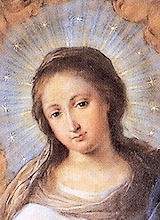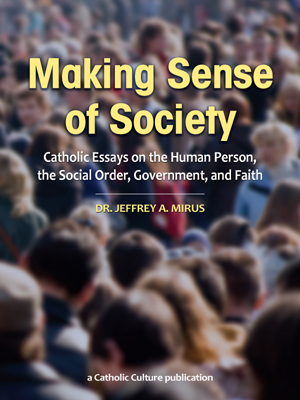May 2024 — Overview for the Month
The Easter season ends on Pentecost, May 20, which is represented by the liturgical color white — the color of light, a symbol of joy, purity and innocence (absolute or restored). The remainder of the month (beginning the Monday after Pentecost) is in Ordinary Time which is represented by the liturgical color green. This symbol of hope is the color of the sprouting seed and arouses in the faithful the hope of reaping the eternal harvest of heaven, especially the hope of a glorious resurrection.
The Holy Father's Intentions for the Month of May 2024
For the Formation of Religious and Seminarians: We pray that religious women and men, and seminarians, grow in their own vocations through their human, pastoral, spiritual and community formation, leading them to be credible witnesses to the Gospel. (See also The Pope's Prayer Intentions.)
Feasts for May
1. Joseph the Worker, Opt. Mem.
2. Athanasius, Memorial
3. Philip and James, Apostles, Feast
5. SIXTH SUNDAY OF EASTER, Sunday
10. Damien de Veuster (USA); John of Avila, Opt. Mem.
12. ASCENSION SUNDAY or the SEVENTH SUNDAY OF EASTER, Solemnity
13. Our Lady of Fatima, Opt. Mem.
14. Matthias, Apostle, Feast
15. Isidore the Farmer (USA), Opt. Mem.
18. John I, Opt. Mem.
19. PENTECOST, Solemnity
20. Blessed Virgin Mary, Mother of the Church; Bernardine of Siena, Memorial
21. Christopher Magallanes & Companions, Opt. Mem.
22. Rita of Cascia; Ember Wednesday, Opt. Mem.
25. Bede; Gregory VII; Mary Magdalene de Pazzi; Ember Saturday, Opt. Mem.
26. TRINITY SUNDAY, Solemnity
27. Augustine of Canterbury, Opt. Mem.
31. Visitation of the Blessed Virgin Mary, Feast
Focus of the Liturgy
The Gospel readings for May are taken from St. John, except for the feast of the Ascension, which is taken from St. Matthew. All are from Year A, Weekdays Year 1.
| May 5 | Year B, John 15:9-17: No one has greater love than this: to lay down one's life for one's friends.
|
| May 12 | Ascension: Year B, Mark 16:15-20: The Lord Jesus was taken up into heaven and took his seat at the right hand of God. Seventh Sunday: Year B, John 17:11b-17: That they may be one just as we are one! |
May 19 | Year B, John 20:19-23: As the Father sent me, so I send you: Receive the Holy Spirit.
|
May 26 | Year B, Matthew 28:16-20: Baptizing them in the name of the Father, and of the Son, and of the Holy Spirit.
|
Highlights of the Month
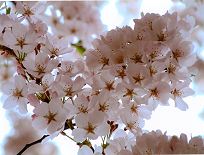 As Spring blossoms forth and we are surrounded by new life, we spend this month full of the joy of our Easter celebration and in anticipation of the coming of the Holy Spirit, our Consoler and Advocate on Pentecost (May 19).
As Spring blossoms forth and we are surrounded by new life, we spend this month full of the joy of our Easter celebration and in anticipation of the coming of the Holy Spirit, our Consoler and Advocate on Pentecost (May 19).
The saints that we will focus on this month—those who have already shared in the rewards of the Resurrection—are:
St. Joseph the Worker (May 1),
St. Athanasius (May 2),
Sts. Philip and James (May 3),
Our Lady of Fatima (May 13),
St. Matthias (May 14) St. Isidore the Farmer (May 15),
St. John I (May 18),
Blessed Virgin Mary, Mother of the Church and St. Bernadine of Siena (May 20),
St. Christopher Magallanes(May 21),
St. Rita of Cascia (May 22),
St. Bede, St. Gregory VII and St. Mary Magdalene de Pazzi (May 25),
St. Augustine of Canterbury (May 27)
and the Visitation (May 31).
The feasts of St. Damien de Vuester (May 10),
St. Nereus & Achilleus, St. Pancras (May 12),
and St. Philip Neri (May 26),
are superseded by the Sunday liturgy. The Solemnity of the Ascension (May 8) is celebrated on May 12 (Sunday) in most dioceses in the United States.
A Time of Grace 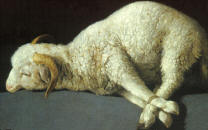 The world is resplendent with Spring's increased light and new growth. It is Mary's month in the Easter season and all of nature rejoices with the Queen of heaven at the Resurrection of the Son she was worthy to bear. During the remainder of Easter time, let us endeavor through the prayers of the Holy Liturgy and the Holy Rosary to deepen our gratitude for the mystery of our Baptismal rebirth in Christ.
The world is resplendent with Spring's increased light and new growth. It is Mary's month in the Easter season and all of nature rejoices with the Queen of heaven at the Resurrection of the Son she was worthy to bear. During the remainder of Easter time, let us endeavor through the prayers of the Holy Liturgy and the Holy Rosary to deepen our gratitude for the mystery of our Baptismal rebirth in Christ.
"The month of May, with its profusion of blooms was adopted by the Church in the eighteenth century as a celebration of the flowering of Mary's maidenly spirituality...With its origins in Isaiah's prophecy of the Virgin birth of the Messiah under the figure of the Blossoming Rod or Root of Jesse, the flower symbolism of Mary was extended by the Church Fathers, and in the liturgy, by applying to her the flower figures of the Sapiential Books—Canticles, Wisdom, Proverbs and Sirach.
"In the medieval period, the rose was adopted as the flower symbol of the Virgin Birth, as expressed in Dante's phrase, 'The Rose wherein the Divine Word was made flesh,' and depicted in the central rose windows of the great gothic cathedrals-from which came the Christmas carol, 'Lo, How a Rose 'ere Blooming.' Also, in the medieval period, when monasteries were the centers of horticultural and agricultural knowledge, and with the spread of the Fransiscan love of nature, the actual flowers themselves, of the fields, waysides and gardens, came to be seen as symbols of Mary..." —John S. Stokes
Pentecost, the birth of the Church, is also among the celebrations of May. Though sprung from the side of Christ on the Cross, the Church marks as her birthday the descent of the Holy Spirit on Mary and the Apostles. At the 'birth' of the world, the Holy Spirit — the Breath of God — was the "mighty wind [that] swept over the waters" (Gen 1:2); at the birth of the Church He is present again "like the rush of a mighty wind" to recreate the world in the image of Christ through His Church (Acts 2:2).
We, the members of Christ's Mystical Body, are the present-day disciples sent by the Holy Spirit to bring Christ to the world. May we go forth as did Mary, who set out in haste to assist St. Elizabeth (feast of the Visitation, May 31). Come upon us, O Holy Spirit, so that, with Mary, we may proclaim the greatness of the Lord who has done great things for us — for his mercy endures forever!
 "In the hierarchy of holiness it is precisely the 'woman', Mary of Nazareth, who is the 'figure' of the Church. She 'precedes' everyone on the path to holiness; in her person 'the Church has already reached that perfection whereby she exists without spot or wrinkle'". —John Paul II Mulieris Dignitatem, 1988
"In the hierarchy of holiness it is precisely the 'woman', Mary of Nazareth, who is the 'figure' of the Church. She 'precedes' everyone on the path to holiness; in her person 'the Church has already reached that perfection whereby she exists without spot or wrinkle'". —John Paul II Mulieris Dignitatem, 1988This item 12548 digitally provided courtesy of CatholicCulture.org




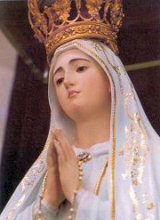
 May 9 or 12
May 9 or 12

 It was to St. Philip that Christ addressed his remark concerning the feeding of the multitude. The roundels represent two loaves of bread.
It was to St. Philip that Christ addressed his remark concerning the feeding of the multitude. The roundels represent two loaves of bread.

 Chosen, by lot, to replace Judas Iscariot, St. Matthias served as a missionary in Judaea, where he is said to have been stoned and beheaded. A battle axe with silver head and tawny handle, white open book with inscription "super Mathiam".
Chosen, by lot, to replace Judas Iscariot, St. Matthias served as a missionary in Judaea, where he is said to have been stoned and beheaded. A battle axe with silver head and tawny handle, white open book with inscription "super Mathiam".
 The fleur-de-lys is a symbol for the Blessed Virgin Mary and is derived from the Madonna's lily.
The fleur-de-lys is a symbol for the Blessed Virgin Mary and is derived from the Madonna's lily.
